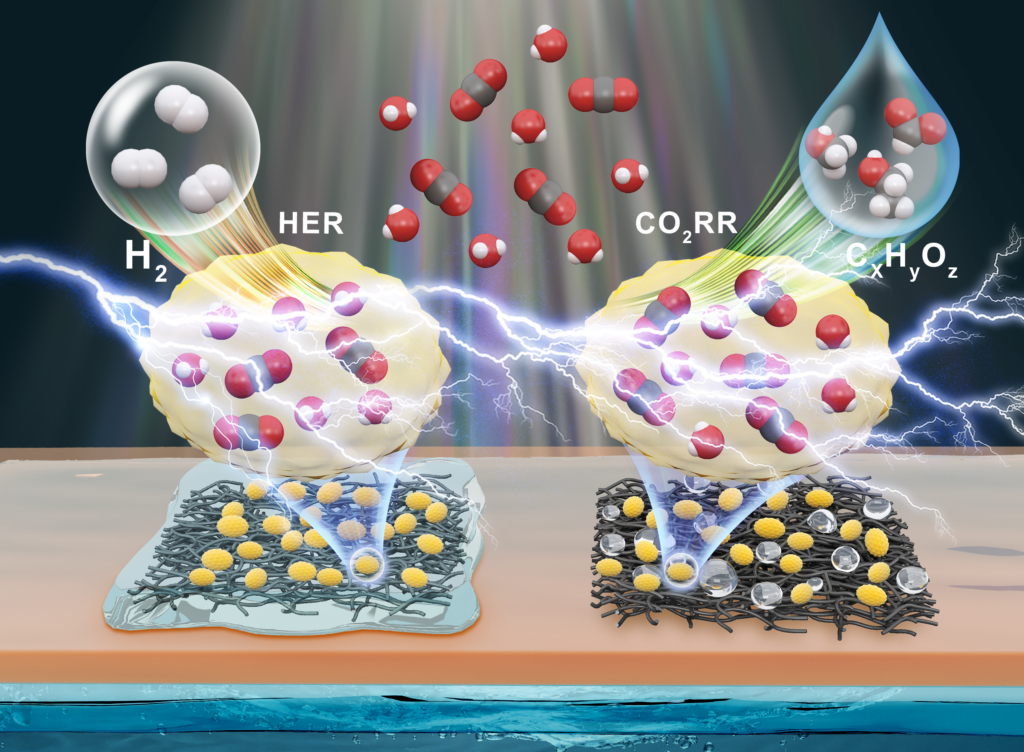
A Zero-Gap Gas Phase Photoelectrolyzer for CO2 Reduction with Porous Carbon Supported Photocathodes
With their variable active sites Metal–organic frameworks (MOFs) can achieve visible-light absorption and efficient charge separation for photocatalytic, and conductivity for electrocatalytic CO2 reduction into value added chemicals. This work illustrates the importance of porous carbon fiber layers (CFLs) on the activity and selectivity of MOF based photocathodes towards the CO2 reduction reaction (CO2RR) in a zero-gap gas phase photoelectrolyzer. The wettability of the CFL modulates the local environment on the metal organic framework catalyst (UiO-66-NH2, yellow coloured). Hydrophobic CFL-based MOF photocathodes lead to CO2RR, producing liquid hydrocarbons ( CxHyOz) such as formate, methanol and ethanol. In contrast, hydrophilic, wetted CFL-based photocathodes favor the Hydrogen Evolution Reaction (HER).The results are a step further in understanding how the design and composition of the photoelectrodes in photoelectrochemical electrolyzers can impact the CO2 reduction efficiency and selectivity.
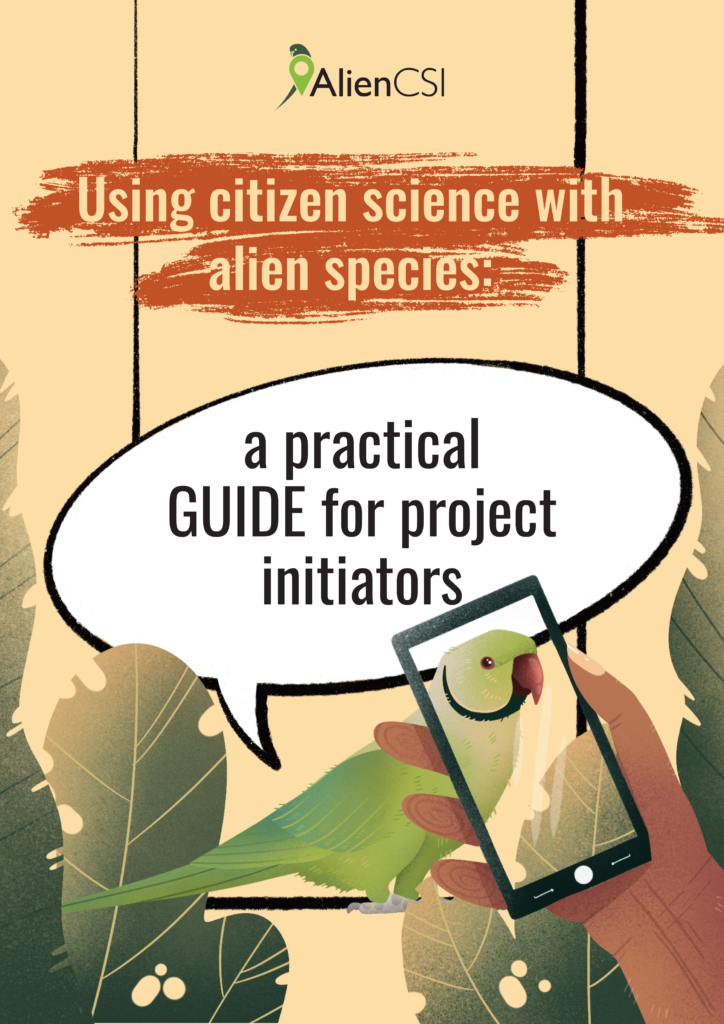
Using citizen science with alien species: a practical guide for project initiators
This guide provides topics to consider when initiating or running a citizen science project on alien species or invasive alien species. It includes key recommendations on how to engage with your target audience, plan and design your project, handle data, perform analyses and evaluate your project outputs. It is intended to help anyone set up an alien species citizen science project. Target people include NGO workers, researchers, policymakers, volunteer groups, government agency workers, project managers, invasive species managers, teachers and the general public. Since there are many published guides on citizen science, this guide summarises the most relevant topics, highlights topics that are more relevant in the context of (invasive) alien species, and refers to other sources of information.
The guide is translated into 23 languages.

Textile Crossroads: Exploring European Clothing, Identity, and Culture across Millennia. Anthology of COST Action "CA 19131 – EuroWeb"
DOI 10.32873/unl.dc.zea.1800
ISBN 978-1-60962-315-9
These essays on various aspects of textile research encompass a wide chronological perspective and vast geographical area, enriching traditional disciplines with innovative methodologies such as isotopic tracing of provenance, textile analysis, protein analysis, digital motion capture, and exploration of textile expressions in texts and folklore. All essays in this volume have been written by international teams of scholars from the participating countries. The anthology serves as a comprehensive and innovative resource, consolidating the research outcomes and insights gained from the interdisciplinary exploration of textiles in European history within the framework of EuroWeb. This volume has the potential to contribute to the advancement of European scientific excellence and competitiveness, fostering a deeper understanding of the cultural, technological, and societal significance of textiles and clothing in shaping European identity and heritage through the millenia. We hope that the anthology will find a wide and interested readership, and that it will inspire many new research projects in the field of textile history.
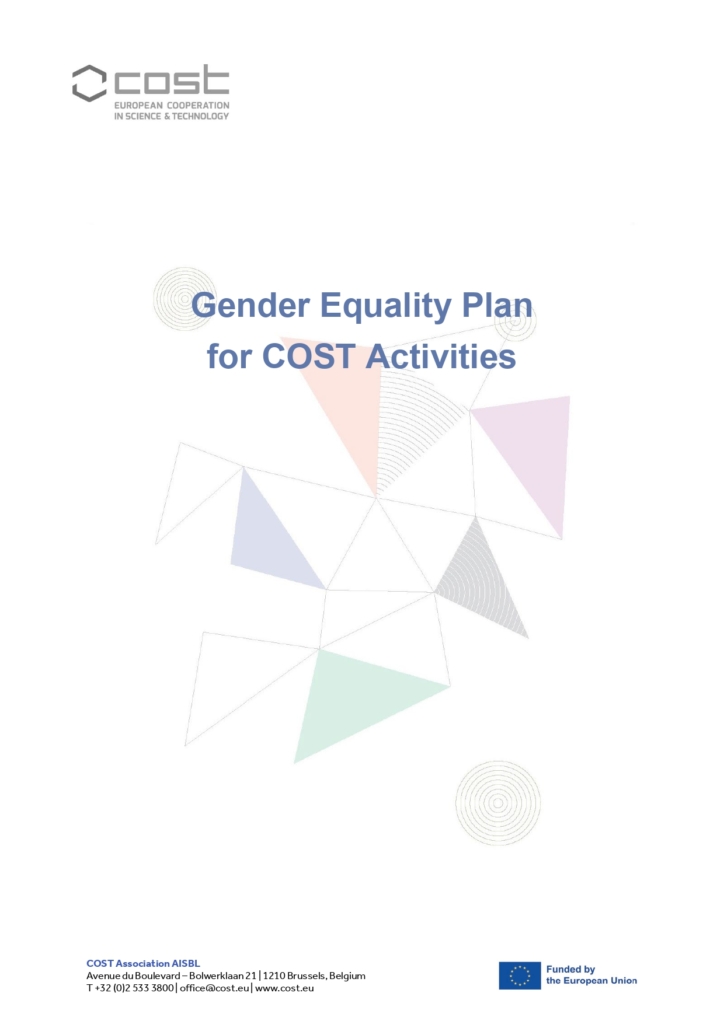
Gender Equality Plan for COST Activities
This Gender Equality Plan (GEP) aims to promote an inclusive culture and a gender dimension in any research carried out in COST Actions, and, where possible, on the additional activities for COST Actions organised by the COST Association. It outlines measures to be taken by COST Actions to make meaningful steps in achieving gender equality.
This GEP will be a ‘living document’, which will allow for details to be developed, adjusted and updated over time.

US4USec: A User Story Model for Usable Security
https://doi.org/10.1007/978-3-031-59465-6_16
Constant integration of new technologies in our daily lives exposes us to various security threats. While numerous security solutions have been developed to protect us from these threats, they fail due to users’ insufficient comprehension of how to employ them optimally. This challenge often stems from inadequate capture of Usable Security (USec) requirements. This paper aims to tackle this issue by proposing US4USec, a User Stories (US) model tailored for capturing USec requirements. US4USec has been constructed based on best practices for the consideration and integration of non-functional requirements (NFR) into US models that have been identified via a Systematic Literature Review (SLR). The coverage and completeness of US4USec have been demonstrated by applying it to a set of security US.
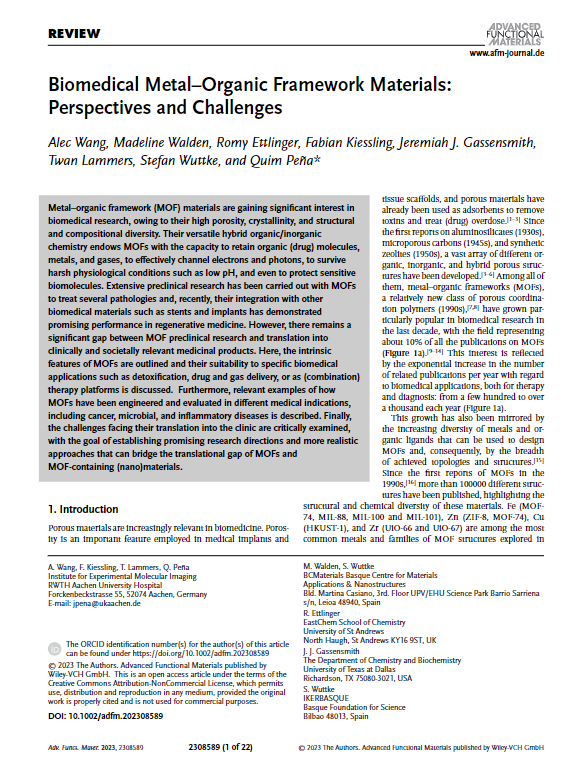
Biomedical Metal–Organic Framework Materials: Perspectives and Challenges
https://doi.org/10.1002/adfm.202308589
Metal–organic framework (MOF) materials have attracted a lot of attention for their potential biomedical applications. They offer unprecedented porosity, tunability, and versatile metal-organic chemistry that can enable novel therapeutic approaches in different indications such as cancer (immuno-)therapy, inflammation, regenerative medicine, and infectious diseases. However, this wealth of preclinical investigation has not translated effectively into the clinic. In this review, we take a translational perspective in analyzing MOF chemistry and the features of MOF (nano-)materials for different biomedical applications. We also assess the remaining barriers to clinical translation of MOFs and critically discuss possible approaches towards realistically bridging the translational gap and, ultimately, generating clinical impact.
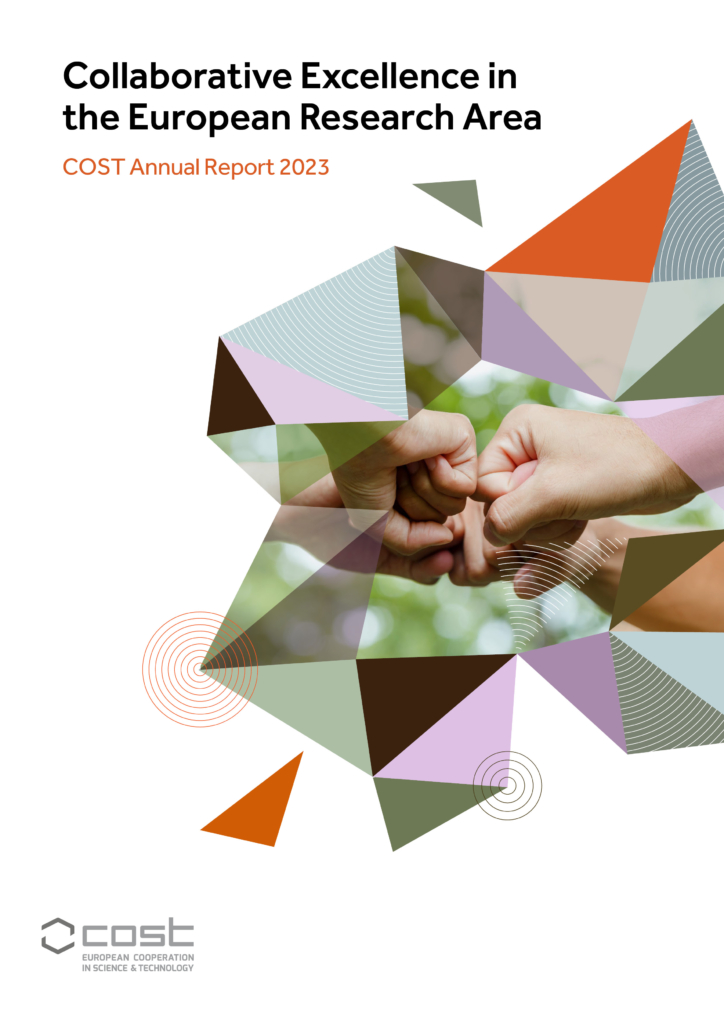
COST Annual Report 2023
COST exists to guide and strengthen collaboration between researchers and innovators to meet the scientific challenges of our time. The COST Annual Report 2023 puts collaboration at it’s heart to show how we support the European Research Area.
This edition depicts 2023’s main highlights, together with key facts and figures from the year. It also features numerous success stories about COST Actions and testimonials from the researchers involved.

COST FP10 Position Paper
Preparations for the 10th EU Framework Programme for Research and Innovation, known as FP10, are underway. Discover why the European Research Area and FP10 need COST.

How to monitor raptors
This section of the ERBfacility Action Advice Hub gives a concise guide to monitoring a range of contextual parameters in raptors, with a focus on those that are (a) most useful for interpretation of pan-European contaminant studies and (b) most feasible to record by many researchers across Europe.
